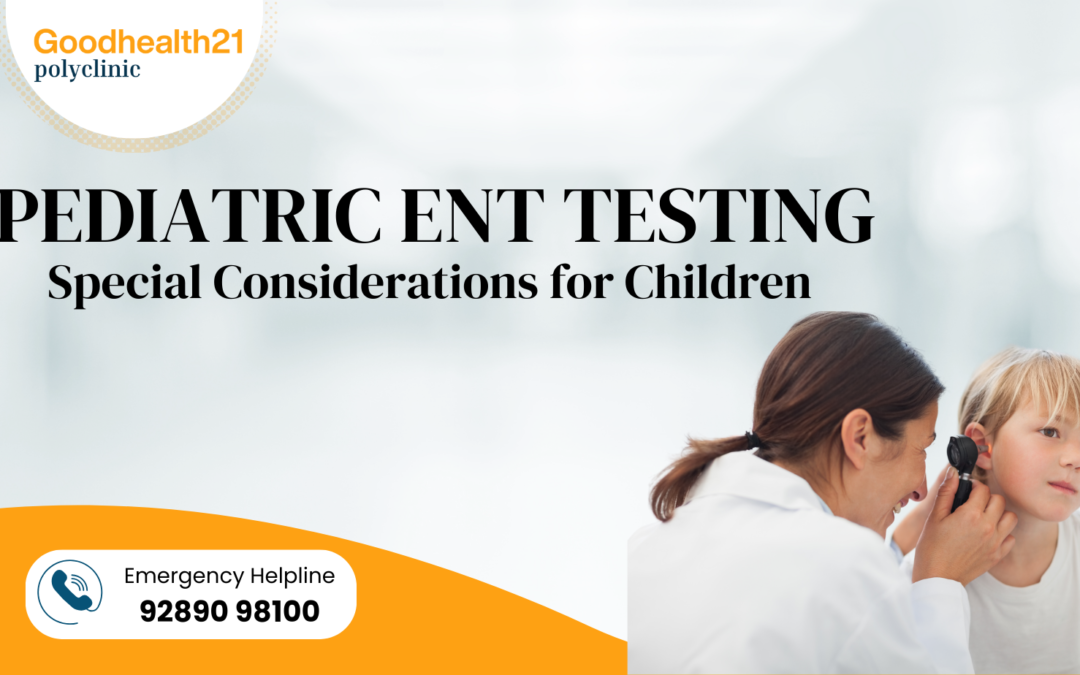Children’s health is a top priority for parents and caregivers, and when it comes to their ear, nose, and throat (ENT) health, special considerations and a child-centered approach are essential. Pediatric ENT conditions can significantly impact a child’s well-being and development, making early diagnosis and appropriate care vital. In this blog, we will explore the unique aspects of pediatric ENT testing and the importance of providing special care for children’s ear, nose, and throat health.
Understanding Pediatric ENT Health
Pediatric ENT health addresses a wide range of conditions that affect the ear, nose, and throat of children. These conditions are unique to pediatric patients and require specialized knowledge and care. Some of the common pediatric ENT conditions include:
1. Otitis Media: Middle ear infections, known as otitis media, are a frequent childhood ailment that can lead to ear pain, fever, and temporary hearing loss.
2. Tonsillitis and Adenoiditis: Inflammation of the tonsils and adenoids can result in recurrent sore throats, difficulty swallowing, and sleep disturbances.
3. Allergies: Allergic rhinitis and other allergic conditions can lead to sneezing, congestion, and throat irritation in children.
4. Speech and Language Disorders: Conditions such as cleft palate, vocal cord dysfunction, or speech sound disorders may require evaluation by an ENT specialist to support speech and language development.
5. Sleep-Related Breathing Disorders: Sleep apnea, often related to enlarged tonsils or adenoids, can significantly impact a child’s sleep and overall health.
The Unique Nature of Pediatric ENT Health
Pediatric ENT health differs from adult ENT health in several ways:
1. Developing Anatomy: Children’s ear, nose, and throat structures are still growing and developing. As a result, some conditions may present differently in children compared to adults.
2. Communication Challenges: Young children may not always articulate their symptoms and discomfort accurately. Healthcare providers must rely on careful observation and communication with both the child and their parents or caregivers.
3. Susceptibility to Infections: Children are more prone to ENT-related infections due to their developing immune systems and exposure to pathogens in daycare or school environments.
4. Impact on Development: Untreated ENT conditions can significantly affect a child’s growth and development. For example, hearing problems can lead to speech and language development issues, while persistent breathing problems can result in sleep disturbances and slowed growth.
Age-Appropriate Pediatric ENT Testing
Pediatric ENT testing involves a variety of examinations and diagnostic procedures that are specifically tailored to children’s unique needs and vulnerabilities. These tests help healthcare providers diagnose and manage ENT conditions in children effectively. Some common age-appropriate tests and considerations include:
1. Visual Inspection: Visual inspection of the ear, nose, and throat is a fundamental part of the examination. For children, this often involves using child-friendly equipment and a gentle approach to avoid causing distress.
2. Tympanometry: Tympanometry is a test used to assess middle ear function. It is frequently employed to diagnose middle ear infections in children, as they are more prone to these infections.
3. Audiometry: Hearing tests for children aim to identify hearing problems early, as untreated hearing issues can significantly impact speech and language development. Age-appropriate tests, such as play audiometry or visual reinforcement audiometry, are used to assess hearing in young children.
4. Flexible Laryngoscopy: In cases of persistent hoarseness or voice changes in children, a flexible laryngoscopy may be used to examine the larynx. The procedure involves a thin, flexible tube with a tiny camera, which is less invasive and more comfortable for children.
5. Imaging Studies: When needed, imaging studies like CT scans or MRI may be conducted to evaluate structural issues or infections in the head and neck.
6. Swallowing Studies: In children with swallowing difficulties or aspiration concerns, a video fluoroscopic swallow study (VFSS) can help assess the swallowing process and guide treatment.
Special Considerations for Pediatric ENT Testing
Healthcare providers must approach pediatric ENT testing with a child-centered, compassionate, and developmentally appropriate mindset. Here are some special considerations for pediatric ENT testing:
1. Child-Friendly Environment: Creating a welcoming, child-friendly environment in the clinic or hospital can help ease a child’s anxiety and fear. Child-sized furniture, colorful decor, and toys can make a significant difference in the child’s comfort.
2. Communication: Healthcare providers should communicate clearly and gently with both the child and their parents or caregivers. Parents’ insights into the child’s symptoms and behavior are invaluable for diagnosis.
3. Playful Approach: Age-appropriate play and communication techniques can help build trust and reduce anxiety. Providers may use toys, storytelling, or games to engage the child during the examination.
4. Distraction Techniques: Distraction techniques, such as using toys or smartphones, can be helpful during procedures or examinations to keep the child calm and cooperative.
5. Family-Centered Care: Recognizing the importance of family in a child’s healthcare journey is crucial. Engaging parents and caregivers as partners in care, providing information, and addressing their concerns fosters a collaborative approach to the child’s well-being.
6. Monitoring Growth and Development: Healthcare providers should monitor a child’s growth and development closely, as ENT conditions can impact these areas. Assessing weight gain, speech development, and other developmental milestones is essential.
Conclusion
Pediatric ENT testing is a vital component of children’s healthcare, aimed at diagnosing and managing a wide range of ear, nose, and throat conditions. The unique nature of children’s ENT health, from developing anatomy to the need for age-appropriate testing, underscores the importance of specialized care. Healthcare providers who approach pediatric ENT testing with a child-centered, compassionate mindset can help ensure the best possible care for young patients and support their overall well-being. Early diagnosis and appropriate management of ENT conditions in children can have a profound impact on their health and development. It is essential to provide special care for children’s ear, nose, and throat health to help them grow and thrive

